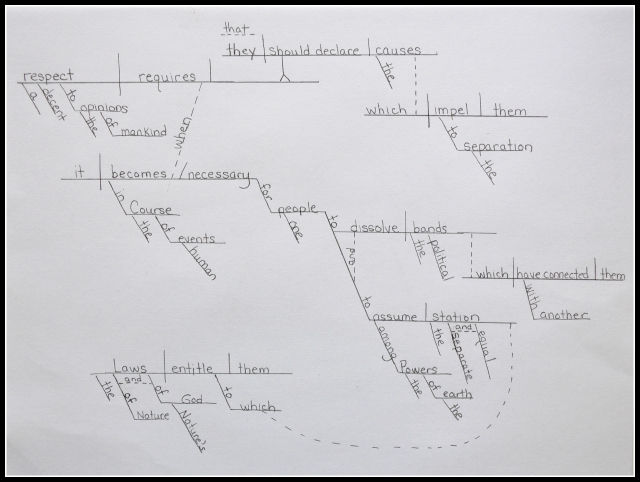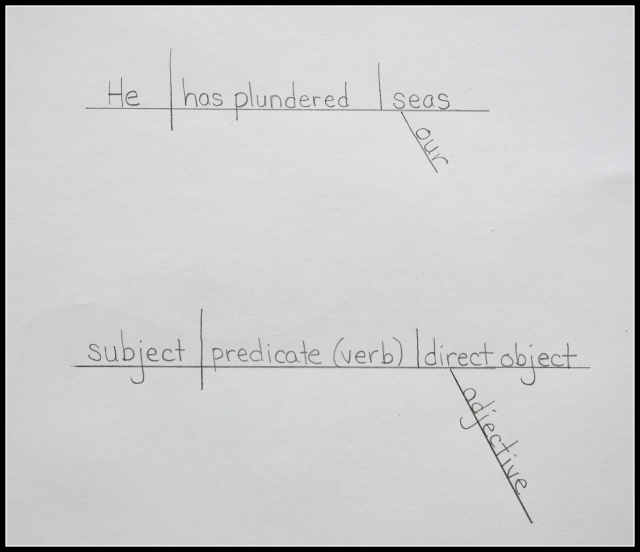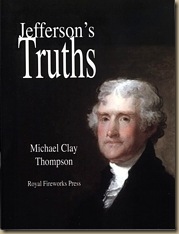"When in the Course of human events, it becomes necessary for one people to dissolve the political bands which have connected them with another, and to assume among the Powers of the earth, the separate and equal station to which the Laws of Nature and of Nature's God entitle them, a decent respect to the opinions of mankind requires that they should declare the causes which impel them to the separation."
I might be the only person to be celebrating Independence Day by diagramming sentences, but (in addition to the other multitude of sentence diagramming benefits) what better way to really think about the words and ideas that helped make us free?!
Here is my guess for this week’s sentence diagramming challenge: (ETA: I diagrammed the compound infinitives incorrectly. They do not modify ‘necessary’ but are actually an appositive for ‘it.’ You can see a correct diagram at this link.)

Did you give that one a try? Or this next one?
"And for the support of this Declaration, with a firm reliance on the Protection of Divine Providence, we mutually pledge to each other our Lives, our Fortunes and our sacred Honor."

(I’m always forgetting words when I re-write the diagrams. (My first, second, third…drafts are always horrendously messy.) I had to add the ‘and’ in there at the last minute when I was editing the photo. Ha!)
If you are just beginning your exciting sentence diagramming adventure (wahooo! for you!), did you try the simple sentence?
“He has plundered our seas.”
Who or what is the sentence about? ‘He.’ That is the subject. What is being said about the subject? He ‘has plundered.’ That is the predicate. It is called a verb phrase because there are two words that work together, the helping or auxiliary verb ‘has’ and the action verb ‘plundered.’ Did something receive the action? What was plundered? ‘Seas.’ That is the direct object. What word tells us more about ‘seas?’ ‘Our.’ That is an adjective modifying the noun ‘seas.’

See how easy that is?! {grin}
(Oh, I’m *not* the only one diagramming for Independence Day! Leigh Bortins is, as well! {grin})
Speaking of grammar and The Declaration of Independence, I have been enjoying Michael Clay Thompson’s book on the subject, Jefferson’s Truths. In fact, I would put it on my must-read list, both for students and their parents.
The description from the MCT website:
“In this volume Thompson shows just how revolutionary were the concepts of the Declaration by relating them to the ideas of the Enlightenment and then focuses on the language and grammar that Jefferson used to announce that revolution. He contrasts the extraordinary dignified tone of the Declaration with other more inflammatory language used in the revolutionary war, and he shows precisely how Jefferson used grammar and vocabulary to achieve the ends he sought.”
Just for fun:



3 comments:
I was all excited to diagram with you again, but we were out of town for the weekend and I've been too busy catching up on laundry and such. I didn't look closely at your diagrams yet, because I might still try them out myself. : )
Have a wonderful 4th of July!
Thanks for the recommendation on the MCT book!
I haven't gotten brave enough to attempt diagramming again. I had an entire semester in college of nothing but diagramming, but I'm afraid to find out how much I've forgotten.
You know, your diagram of the introduction to the Declaration of Independence is similar to Phyllis Davenport's in "Rex Barks" (assuming I have decoded her frame correctly). She places people as doing the action of the compound infinitives (objective case subject).
Interesting to think about.
Post a Comment